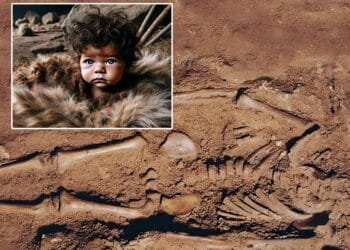A team of archaeologists, led by Professor Luca Bombardieri from the University of Siena, has unearthed a 4,000-year-old temple believed to be the oldest sacred site on the island of Cyprus.

The temple was discovered in Erimi, a village near Limassol, as part of the Erimi Archaeological Project, an initiative involving collaboration between the University of Siena, the Department of Antiquities of Cyprus, and various other institutions. This extensive research effort has been ongoing for 15 years.
Located within a larger complex that includes residential units, workshops, and a burial site, the temple was part of an artisan community that thrived during the Middle Bronze Age (approximately 2000-1600 BCE). The site is perched on a high limestone terrace overlooking the Kouris River and the Gulf of Kourion, providing a strategic and picturesque setting for the ancient settlement.
At the heart of the temple is an enigmatic monolith, standing about 2.30 meters (approximately 7.5 feet) tall. This smooth, polished stone features a circular motif of small cups at its center, which researchers believe played a significant role in the rituals and ideology of the ancient community. The monolith was initially situated in the center of a rectangular room, surrounded by an amphora and a hearth, allowing for circulation around these central artifacts. This layout suggests the room’s use as a sacred space within the workshop complex.

Professor Bombardieri described the monolith and its surroundings in a press release. “The peculiarities of this space, especially when compared to the surrounding production workshop spaces, indicate that it is a small sacred space—the oldest effectively documented on this island,” Bombardieri explained.
In addition to the temple, the excavation uncovered the skeletal remains of a young woman, estimated to be around 20 years old. The evidence suggests that she was the victim of a violent death, possibly a case of ancient femicide. Her skull bore signs of a severe fracture, likely inflicted by a spear or a heavy object. Her body was found with a large stone placed on her chest, a practice that may have been intended to immobilize her remains and prevent her spirit from haunting the living. The absence of valuable items or ceremonial objects near her body indicates that no formal burial rites were performed.

Bombardieri suggested that this case might be linked to other similar incidents recorded in various parts of Cyprus, where young women were killed and isolated from their communities, possibly due to issues related to maternity. The entrance to the small dwelling where the woman was found had been meticulously sealed, resembling a tomb.
The findings from Erimi provide valuable information about the lives and practices of an early Bronze Age community. The settlement, known for producing wine-colored textiles, was abruptly abandoned and preserved for millennia after a fire, which may have been set by fleeing villagers. This fire caused the temple’s roof to collapse, effectively sealing and preserving the site.

“The collapse of the structure, sealing off those remains, has enabled us archaeologists to rediscover them after four thousand years,” Bombardieri said. Researchers hope that future excavations will uncover more about this ancient community.


























